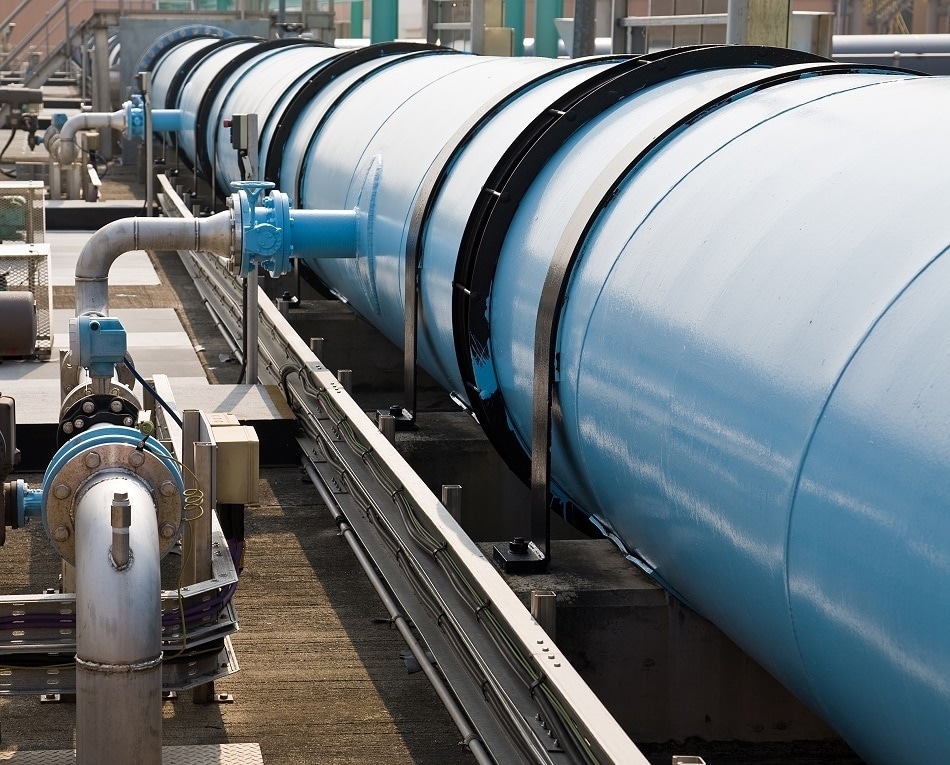
AZoM speaks to Trevor Foster on the expanding roles of ultrasonic flowmeters. Trevor draws upon over 40 years of using innovative design and production techniques to produce elegant flow metering solutions for organisations around the globe.
What are the main reasons for people wanting to meter the flow of fluids?
There is no single main reason for wanting to measure flow but often the prime drivers are associated with control. Be it the control of processes, product quality, medical requirements, or people’s actions.
Flowmeters are used in a wide variety of processes from the measurement of crude oil and the small amount of additive chemicals employed to ensure easy and safe handling through to the mass air flowmeter in a car’s engine to ensure a legal and economic combustion of the refined fuel. There are many examples of flowmeters being crucial to product quality. For example precisely metering the amount of a critical fluid used in the manufacture of a drug or simply ensuring that a coolant (or heating) fluid flow is keeping the process within operational parameters. Would you enjoy drink from the coffee machine if it was dispensed in different volumes with different strengths every time?
In the operating theatre anaesthetists have the technology to monitor the gases flow being administered to patients, sometimes the blood flow and now even the volume of a drug being supplied intravenously. Kidney dialysis machines and numerous other pieces of medical equipment use meters. The amount of coolant delivered to a patient’s scalp can reduce the amount of hair loss during cancer treatment but the flow rate (heat extraction) is controlled by a flowmeter and careful temperature monitoring. Currently government and utility companies are encouraging UK customers to install “smart meters” (gas, electric and water). This strategy is designed to make people aware of the wastage of these resources and so modify their actions. Tug operation companies fit flowmeters to prevent/inform the captains that jamming the throttles fully open for the often long trip back to harbour is very expensive. These vessels are about power not speed and operating them at full power just to go a tiny faster is a big mistake as there is very little speed increase for a an enormous increase in fuel being burnt. Pub companies install meters which not only measure the beer flow but also monitor the temperature of the beer and whether the lines have been cleaned so that they can ensure a good quality product for their customers. On a large scale the data collected will also provide a very valuable consumer behaviour report for future marketing exercises.

How do Titan ultrasonic flowmeters work?
There are two basic methods of ultrasonic flowmeter operation, Doppler shift and time of flight measurement.
Time of flight (as used by Titan) is the preferred technique for flowmeters as it returns the best performance. In time of flight ultrasonic flowmeters, sound is injected into the fluid, which travels with the flow until it is received further downstream. A signal is then injected from the received position which then travels back to the first transmission point against the flow. Because of the fluid movement the signal travels faster with the flow than it does against it. The phase shift between these two waveforms is directly proportional to the fluid velocity and the further the sensors are apart the greater the phase shift. As the pipe geometry is known so is the volumetric flow.
Doppler shift utilises the fact that sound traveling towards a receiver is accelerated whereas sound travelling away is slowed down. The classic example is a car approaching a listener. The engine note has a raised pitch as it approaches and a dropped pitch when it recedes. The amount pitch changes will depend entirely on the speed of the car as the sound waves are bunched up and stretched out more or less. If ultrasound is injected into a fluid stream it will travel until it hits something moving within the fluid that causes the sound to be reflected back to the source. As with the car the faster this reflector is moving the greater the increase in frequency when the signal arrives back at the transmitter. This system requires something to reflect the ultrasound back to the receiver which is usually impurities in the fluid.
Clamp-on ultrasonic flowmeters can be based on either operating system but increasingly are time of flight devices.


 Please click here if you would like more information on the instrument used in this article or a quote
Please click here if you would like more information on the instrument used in this article or a quote
What benefits do ultrasonic flowmeters offer over other flow techniques?
The main benefits of ultrasonic flowmeters are:-
- Low pressure drop as the flowmeter bore is often the same as the pipe bore.
- The ability to meter a wide variety of liquids as they are not dependent on fluid conductivity or Reynolds number unlike electromagnetic or mechanical meters.
- High accuracy for compact assemblies. An accurate in-line ultrasonic meter can be quite short unlike a Coriolis meter of similar size.
- Perfect for large pipes. A 1 metre flowmeter of almost any other type would be bulky. The equivalent ultrasonic device would have a number of transmitter receivers set on an angle on perhaps a 1 metre length of pipe with an associated electronic box.
For which industries and applications are ultrasonic flowmeters the tool of choice?
As I mentioned previously - traditionally ultrasonic meters have been THE meter of choice for large pipes. These can be multipath devices capable of extremely high accuracy. Ultrasonic flowmeters are trusted devices for fluid custody transfer as they are able to maintain their performance for long periods of time.
Another important application is to ascertain the unknown flow in a larger diameter pipe (say 25mm and above) - the simplest way of doing this is to use a clamp-on ultrasonic flowmeter which can provide an invaluable diagnostic tool. This use of ultrasonic flow metering has resulted in very low flow (low accuracy) medical devices for monitoring blood flow in blood vessels during critical operations.

How have Titan improved ultrasonic flowmeter technology?
Simply by tearing up the rulebook and making ultrasonic flowmeters work well with low flows. This innovation is shown by the two patents granted to Titan Enterprises with further patents pending. Our development of unique algorithms and techniques has resulted in a new generation of low flow ultrasonic flowmeters that work well. R&D at Titan has even produced designs where we can send ultrasound round corners. The lowest flow ultrasonic device we have produced so far has a 28mm diameter loop of one and a half turns of 1mm bore tube. This device can accurately measure flows as low as 0.25 ml/minute e.g. delivering a spoon of medicine in 20 minutes. Recently Titan demonstrated an ultrasonic flow device for domestic water metering that which can detect leaks of just 25ml /minute from a 50 litre per minute flow. We are currently also working on methods of using ultrasonic technology to meter very high pressure within small bore tubes which would not have been previously possible.

What services and support do Titan offer in addition to flow instruments and software?
Ninety five percent of our business are repeat orders from satisfied customers, a fact we are very proud of. For larger OEM projects, we undertake consultative research and development for often several years to make sure that the measurement solution we are offering is ideal for their application. In such projects, we have the expertise, facilities and resource to design and test custom moulded products and be involved in pre-production and suitability trials. As flowmeter solution providers we will tailor our existing products or completely design, test and tool a metering system for a specific application. Mid volume OEM’s with a critical flow measurement requirements are our typical customers. Such organisations require a reliable yet affordable product which cannot be fulfilled by a 1 dollar device from the internet or a 3000 dollar Coriolis meter.
What areas of research are Titan investigating to further develop their ultrasonic flowmeter technology?
As I mentioned earlier we believe we have the best small bore ultrasonic system in the world today. We have just launched the Atrato Metraflow meter which has a PFA tube with sensors attached to the outside of the pipe. This gives an ultra-pure fluid path and there are no disruptions or changes in section making the device ideal for critical material handling. Our current R&D effort is focused on low cost water meters and some derivatives for OEM use. These products will be low cost but the basic technology could be equally transferable to a smart water meter with remote reading and all the other good things that a non-mechanical electronic based device can bring. We have some new ideas for algorithms which will permit us to accurately meter small bore thick wall tubes at pressures up to 1000 Bar. We can already do this but have to compensate for several variables which the new system would make automatic. Clamp-on medical devices that deliver better accuracies that the current ±5% with a limited range is another system we want to perfect as this could be used in laboratories as well. I would like to see most of our mechanical products replaced with ultrasonic devices as I see this as the main future of flow measurement.
About Trevor Forster

Trevor Forster is Managing Director of Titan Enterprises. His experience in fluid handling dates back to the mid 1960's when he started working on rotating seals and flowmeter design for third party clients. Trevor draws upon over 40 years of using innovative design and production techniques to produce elegant flow metering solutions for organisations around the globe.
Disclaimer: The views expressed here are those of the interviewee and do not necessarily represent the views of AZoM.com Limited (T/A) AZoNetwork, the owner and operator of this website. This disclaimer forms part of the Terms and Conditions of use of this website.